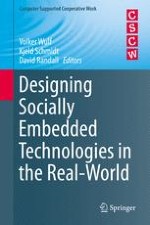2015 | OriginalPaper | Chapter
11. Building Socially Embedded Technologies: Implications About Design
Authors : Federico Cabitza, Carla Simone
Published in: Designing Socially Embedded Technologies in the Real-World
Publisher: Springer London
Activate our intelligent search to find suitable subject content or patents.
Select sections of text to find matching patents with Artificial Intelligence. powered by
Select sections of text to find additional relevant content using AI-assisted search. powered by
